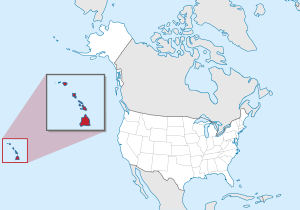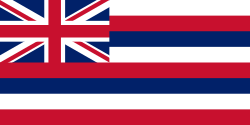Hawaii
| Hawaii |
Mazie Hirono (D) |
Jill Tokuda (D) |
Hawaii is a state in the Western United States, located in the Pacific Ocean about 2,000 miles from the U.S. mainland. It is the only U.S. state outside North America, the only state that is an archipelago, and the only state in the tropics.
Hawaii comprises nearly the entire Hawaiian archipelago, 137 volcanic islands spanning 1,500 miles (2,400 km) that are physiographically and ethnologically part of the Polynesian subregion of Oceania. The state's ocean coastline is the fourth longest in the U.S., at about 750 miles (1,210 km). The eight main islands, from northwest to southeast, are Niʻihau, Kauaʻi, Oʻahu, Molokaʻi, Lānaʻi, Kahoʻolawe, Maui, and Hawaiʻi, after which the state is named; it is often called the "Big Island" or "Hawaii Island" to avoid confusion with the state or archipelago. The uninhabited Northwestern Hawaiian Islands comprise most of the Papahānaumokuākea Marine National Monument, the nation's largest protected area and the third largest globally.
Of the 50 U.S. states, Hawaii is the eighth-smallest in land area and the 11th-least populous, but with 1.4 million residents, it ranks 13th in population density. Two-thirds of the population lives on O'ahu, home to the state's capital and largest city, Honolulu. Hawaii is among the country's most diverse states, owing to its central location in the Pacific and over two centuries of migration. As one of only six majority-minority states, it has the nation's only Asian American plurality, its largest Buddhist community, and the largest proportion of multiracial people. Consequently, it is a unique melting pot of North American and East Asian cultures and its indigenous Hawaiian heritage.
Settled by Polynesians sometime between 1000 and 1200 CE, Hawaii was home to numerous independent chiefdoms. In 1778, British explorer James Cook was the first non-Polynesian to arrive at the archipelago; early British influence is reflected in the state flag, which bears a Union Jack. An influx of European and American explorers, traders, and whalers arrived shortly after leading to the decimation of the once isolated Indigenous community by introducing diseases such as syphilis, gonorrhea, tuberculosis, smallpox, measles, leprosy, and typhoid fever, reducing the native Hawaiian population from between 300,000 and one million to less than 40,000 by 1890.
Hawaii became a unified, internationally recognized kingdom in 1810, remaining independent until Western businessmen overthrew the monarchy in 1893; this led to annexation by the U.S. in 1898. As a strategically valuable U.S. territory, Hawaii was attacked by Japan on December 7, 1941, which brought it global and historical significance and contributed to America's decisive entry into World War II. Hawaii is the most recent state to join the union, on August 21, 1959. In 1993, the U.S. government formally apologized for overthrowing Hawaii's government, spurring the Hawaiian sovereignty movement.
Historically dominated by a plantation economy, Hawaii remains a major agricultural exporter due to its fertile soil and uniquely tropical climate in the U.S. Its economy has gradually diversified since the mid-20th century, with tourism and military defense becoming the two largest sectors. The state attracts tourists, surfers, and scientists from around the world with its diverse natural scenery, warm tropical climate, an abundance of public beaches, oceanic surroundings, active volcanoes, and clear skies on the Big Island. Hawaii hosts the U.S. Pacific Fleet, the world's largest naval command, as well as 75,000 employees of the Defense Department.
Although its relative isolation results in one of the nation's highest living costs, Hawaii is the third-wealthiest state.
Pearl Harbor
Oʻahu was the target of a surprise attack on Pearl Harbor by Imperial Japan on December 7, 1941. The attack on Pearl Harbor and other military and naval installations, carried out by aircraft and by midget submarines, brought the United States into World War II.
Attack on Pearl Harbor
The attack commenced at 7:48 a.m. Hawaiian Time (6:18 p.m. GMT). The base was attacked by 353 Imperial Japanese aircraft (including fighters, level and dive bombers, and torpedo bombers) in two waves, launched from six Japanese aircraft carriers. Of the eight US Navy battleships present[Note 1], all were damaged, with four sunk[Note 2]. All but USS Arizona were later raised, and six were returned to service and went on to fight in the war. The Japanese also sank or damaged three cruisers[Note 3], three destroyers [Note 4], an anti-aircraft training ship, and one minelayer. More than 180 US aircraft were destroyed. 2,403 Americans were killed and 1,178 others were wounded. Critical base installations such as the power station, dry dock, shipyard, maintenance, and fuel and torpedo storage facilities, as well as the submarine piers and headquarters building (also home of the intelligence section), were not attacked.
Japanese losses were light: 29 aircraft and five midget submarines were lost, and 64 servicemen were killed. {{wikimain|Attack on Pearl Harbor
Etymology
The state of Hawaii derives its name from the name of its largest island, Hawaiʻi. A common Hawaiian explanation of the name of Hawaiʻi is that it was named for Hawaiʻiloa, a legendary figure from Hawaiian myth. He is said to have discovered the islands when they were first settled.
LGBT
Hawaii has had a long history of LGBT identities. Māhū ("in the middle") were a precolonial third gender with traditional spiritual and social roles, widely respected as healers. Homosexual relationships known as aikāne were widespread and routine in ancient Hawaiian society. Among men, aikāne relationships often began as teens and continued throughout their adult lives, even if they also maintained heterosexual partners. While aikāne usually refers to male homosexuality, some stories also refer to women, implying that women may have been involved in aikāne relationships as well. Journals written by Captain Cook's crew record that many aliʻi (hereditary nobles) also engaged in aikāne relationships. Kamehameha the Great, the founder and first ruler of the Kingdom of Hawaii, was also known to participate. Cook's second lieutenant and co-astronomer James King observed that "all the chiefs had them" and recounts that Cook was actually asked by one chief to leave King behind, considering the role a great honor.
Hawaiian scholar Lilikalā Kameʻeleihiwa notes that aikāne built mutual trust and cohesion; "If you didn't sleep with a man, how could you trust him when you went into battle? How would you know if he would be the warrior that would protect you at all costs, if he wasn't your lover?"
As Western colonial influences intensified in the late 19th and early 20th century, the word aikāne was expurgated of its original sexual meaning, and in print meant "friend". Nonetheless, the Hawaiian language publications' metaphorical meaning can still mean either "friend" or "lover" without stigmatization.
A 2012 Gallup poll found that Hawaii had the highest proportion of LGBT adults in the U.S., at 5.1%, an estimated 53,966 individuals. The number of same-sex couple households in 2010 was 3,239, representing a 35.5% increase from a decade earlier. In 2013, Hawaii became the fifteenth U.S. state to legalize same-sex marriage; this reportedly boosted tourism by $217 million.
History of the Hawaii Flag
The Hawaii State Flag features eight horizontal stripes alternating between red, white, and blue. In the top left-hand corner of the flag is the "Union Jack" (flag of the United Kingdom).
Hawaii is a collection of 137 islands located in the central Pacific ocean which were formed by volcanic activity. The Hawaiian islands are located 2,397 miles west of San Francisco and 5,293 miles east of Manila, the capital of the Philippines. Polynesians first inhabited the islands, who lived in total isolation for more than 500 years. The first European to discover the islands was James Cook, who arrived in 1778. Cook named the islands "Sandwich Islands" after John Montague (the 4th Earl of Sandwich). Within five years of Cook's arrival, the British had conquered and unified the Hawaiian islands and established the "Kingdom of Hawaii" in 1795. After the British discovered the islands, wealthy Americans began immigrating to the islands seeking land to start sugar plantations. In conjunction with this, many people from Asia (Japan, China, and the Philippines) began immigrating to the islands in search of work as plantation laborers.
During this period, Hawaii flew the British Flag unofficially. The first leader of the Republic of Hawaii, King Kamehameha I, was concerned that flying the British flag during the War of 1812 signaled Hawaii's loyalty to Britain and could anger their allies in the United States. At one point, he was said to have flown an American Flag as to not anger the Americans, which in turn angered the British. Eventually, in 1816, Kamehameha commissioned a flag that featured elements of both the British Flag and the American Flag to be used as the Hawaiian Flag. The red, white, and blue stripes paid homage to the American Flag, while the British Flag's inclusion in the canton symbolized Great Britain. Since 1816, the arrangement of the stripes and number of stripes has changed/varied slightly. However, the flag that Kamehameha commissioned is essentially the same as the Hawaiian Flag flown today. Hawaii is the only US State flag that features a foreign country's flag. The eight stripes on the flag represent the eight major islands of Hawaii which are Hawai'i, Maui, Kaho'olawe, Lana'I, Moloka'i, O'ahu, Kaua'I, and Ni'hau).
In 1893, the "Kingdom of Hawaii" became the "Republic of Hawaii" for a short period and in 1898, the government agreed to join the United States of America as the "Territory of Hawaii." The islands became an official state on August 21st, 1959 and the 50th state of the United states of America. Hawaii was one of the few states that was independent before it became a state (the others are Vermont, Texas, and California).
Hawaii is located in Oceania. It is one of only two US states that does not share borders with any other states (the other one being Alaska). It is also the only state composed entirely of islands and the only state outside North America. The largest and capital city of Hawaii is called Honolulu, which translates as "sheltered harbor" or "calm port." Hawaii is referred to as "The Aloha State" as "Aloha" has various meanings, including love, affection, peace, compassion, mercy, hello and goodbye, and is the most used word in Hawaii and often used as a greeting.
Hawaii is home to some of the worlds most beautiful white sand beaches with crystal clear waters. The most famous beach in Hawaii is Waikiki Beach. An extinct volcano called "Diamond Head" is another popular tourist destination, located at the end of Waikiki. Another famous landmark in Hawaii is the "USS Arizona Memorial" at Pearl Harbor, which is the burial place of 102 sailors and marines who lost their lives during the Japanese attack on Pearl Harbor on December 7th, 1941.
Notes
- Wikipedia article: Hawaii
Chat rooms • What links here • Copyright info • Contact information • Category:Root

